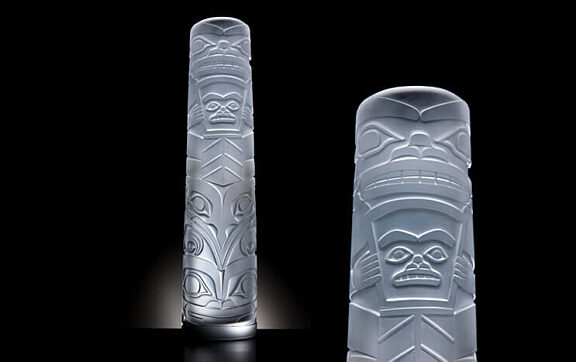Preston Singletary’s Coppers

1st May 2013
The artwork of Preston Singletary is rich with cultural symbolism. He is often asked about the different forms and symbols used in the pieces he makes, so we are starting a blog series that will help explain some of the artistic, spiritual, historical, and anthropological meanings behind some of Preston’s most recognizable works.
For our first post, we will look at the Tináa, or Copper Shield form. Preston has used it several times in various works throughout the years. He references it as an item of clan treasure and symbolic wealth.
According to anthropologists, the copper shield form, or tináa, is ancient and possibly Asiatic in origin (dating from before the peoples now known as Native Americans crossed the land bridge more than 12,000 years ago). They symbolized the wealth of the clan, both due to the monetary value of the copper and other supernatural meanings attributed to copper as it occurs in nature. In many myths, the discovery of copper was tantamount to an encounter with a supernatural being. Although copper was historically used only by a chief, myths sometimes portray the discoverer of copper as low in status, with their status rising when they find it. The discovery of copper not only gives the finder tangible evidence of contact with the supernatural, but also manifests the element of luck, which has its own magical connotations. The discovery of copper in its natural state ensured wealth. Wealth was considered the outward manifestation of power, which was believed to be supernaturally endowed or acquired.
From Northwest Tribal Arts:
The "Copper" was used by the First Nations people as a form of money and wealth. It was made out of "Native" copper which was found in the land where they lived, and superficially resembled a shield. Considered very rare and hard to obtain, raw copper was traded from the Athabaskan Indians in the Interior Plains, or from the white man in later times.
Coppers were beaten into shape and usually painted or engraved with traditional designs. Most Coppers were fairly large, often 2 to 3 feet tall and a foot across.
One of the most interesting aspects of the Copper is that they were given names so that their worth and heritage could be passed on. A Copper was only worth what it was last traded for, and it could only be traded for a larger amount the next time around. Consequently, some Copper values became highly valuable - worth the total of 1,500 to 2,000 blankets, a couple of war canoes and hundreds of boxes and bowls.
No matter what the original value was the next person who wanted it had to trade more in exchange for it. Only the richest and most powerful could afford the price of an old Copper. Many Coppers were in rather shabby condition as a result of having been used in quarrels between Chiefs.
To the Kwakiutl, the ownership and display of a Copper became an essential for the proper conduct of a marriage or important dance ritual.
A man whose family's honour had been injured by the actions of remarks of another would publicly have a piece cut from a valuable Copper and give the piece to the offender. That person was obligated to cut or "break" a Copper in return. The broken pieces could be brought up and joined into a new Copper or used to replace pieces missing from a "broken" one.
The most valuable Kwakiutl Coppers tend to be rough and patched since they have the longest history and have been broken the most often. Coppers that have been broken have a certain prestige value that is quite independent from their monetary value.



